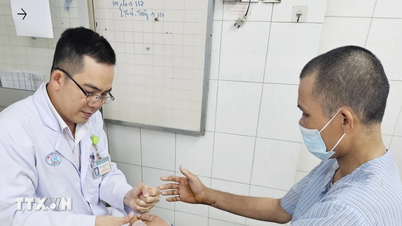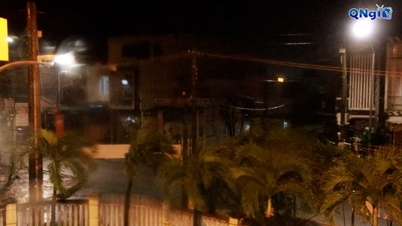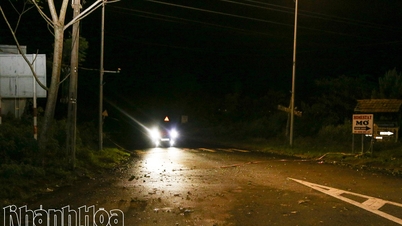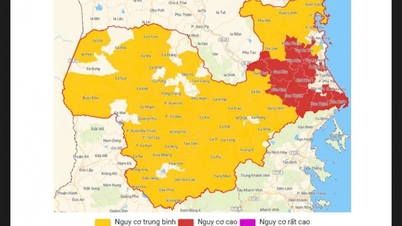Guangdong province, southern China, is facing the most serious outbreak of chikungunya since the virus appeared in the country in 2008. More than 7,000 cases have been recorded since July, mostly in the city of Foshan.
Chikungunya, transmitted by the Aedes mosquito, is rarely fatal but can cause high fever, rashes and joint pain. Experts say the surge in cases this year is due to international travel , unusually hot weather and prolonged heavy rains.
Chinese authorities are launching a large-scale mosquito-killing campaign to prevent the spread of the virus by releasing flesh-eating mosquitoes and larval-killing fish.
Poster calling on people to kill mosquitoes and clean the environment to limit the spread of disease in China (Photo: Reuters).
One of the “weapons” used is the giant mosquito Toxorhynchites – dubbed the “flesh-eating mosquito” because its larvae feed on Aedes mosquito larvae – the agent that transmits chikungunya and dengue fever.
According to a 2024 study published in the Journal of Tropical Medicine , a single Toxorhynchites larva can kill thousands of other mosquito larvae. They also have a “kill-don’t-eat” behavior – killing the larvae but leaving the bodies behind.
Another advantage is that adult Toxorhynchites mosquitoes do not suck blood, so they do not transmit the disease through bites, said Professor Eng Eong Ooi, a researcher at the Emerging Infectious Diseases Programme at Duke-NUS Medical School (Singapore).
"By releasing Toxorhynchites mosquitoes, the Chinese government hopes to reduce the number of Aedes mosquitoes, thereby controlling the spread of chikungunya virus. However, the effectiveness depends on the frequency, the number of mosquitoes released and the specific species of Toxorhynchites used," he said.
China is not the first country to use this method. The United States, Malaysia and India have also released “flesh-eating” mosquitoes with varying results. In New Orleans (USA), the number of Aedes mosquitoes decreased by 45% after implementation.
In addition, a research team from Sun Yat-sen University (Guangdong) also released 5,000 larval-eating fish to destroy mosquito eggs hatching in the lake.
Aedes mosquitoes don’t just lay their eggs in lakes and ponds; they breed in any small container of standing water, from potted plants to discarded bottles. They thrive in the hot, humid, rainy conditions common in southern China.
Foshan authorities have also introduced other measures to raise awareness of environmental hygiene. Residents will be cut off from electricity or fined up to 10,000 yuan (more than £1,000) if they fail to clean up stagnant water. Sick people are being asked to sleep under mosquito nets and take other measures to limit the spread of the disease.
Authorities also used drones to detect stagnant water and launched a massive mosquito-spraying campaign across the city.
Drones spray insecticide around streets and residential areas in China (Photo: Getty).
Authorities say that while there were 3,000 new cases last week alone, the number appears to have peaked and 95% of patients are discharged within seven days.
The chikungunya virus was first discovered in Tanzania in 1952 and has since spread to 110 countries, mainly in sub-Saharan Africa, Southeast Asia and South America. Today, the disease is present on nearly every continent.
This year, the epidemic has exploded in the tropics. Since the beginning of the year, Indian Ocean islands such as La Réunion have recorded 54,000 cases and 12 deaths.
The outbreaks in countries like France and China occurred as the Aedes mosquito expanded its range, helped by climate change and urbanization, creating new habitats. In these areas, communities had never been exposed to the virus, leading to a large enough proportion of the population lacking immunity for the disease to spread rapidly.
Source: https://dantri.com.vn/suc-khoe/trung-quoc-tha-muoi-an-thit-de-day-lui-benh-chikungunya-20250813142455125.htm





![[Photo] Closing of the 14th Conference of the 13th Party Central Committee](https://vphoto.vietnam.vn/thumb/1200x675/vietnam/resource/IMAGE/2025/11/06/1762404919012_a1-bnd-5975-5183-jpg.webp)



![[Photo] Prime Minister Pham Minh Chinh receives the delegation of the Semiconductor Manufacturing International (SEMI)](https://vphoto.vietnam.vn/thumb/1200x675/vietnam/resource/IMAGE/2025/11/06/1762434628831_dsc-0219-jpg.webp)








































































































Comment (0)